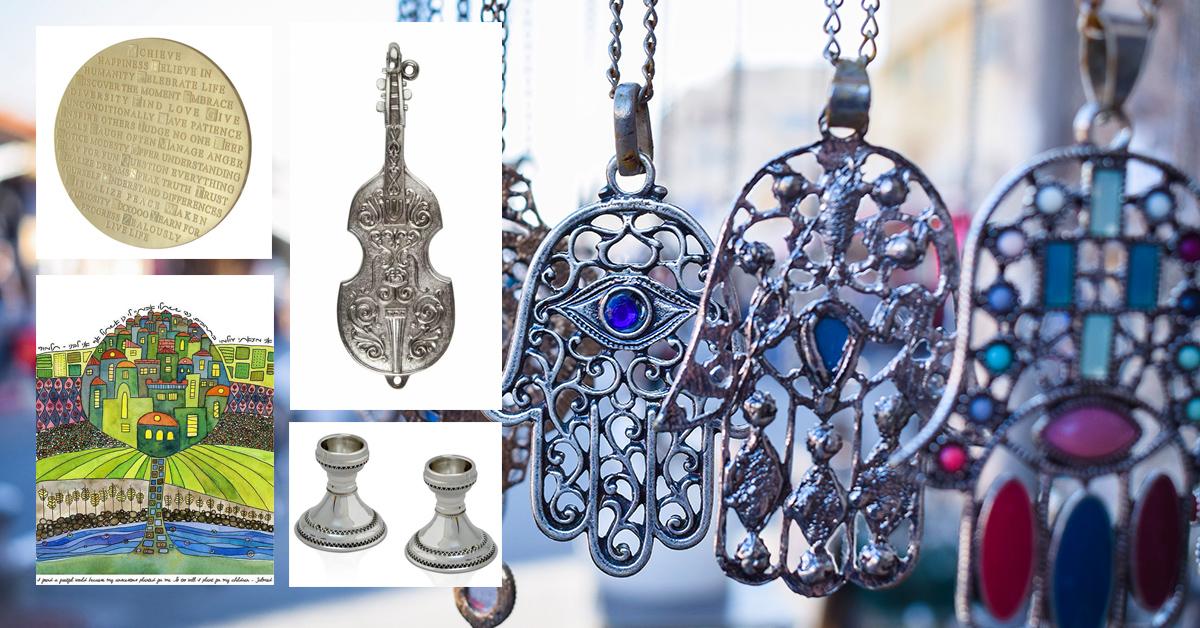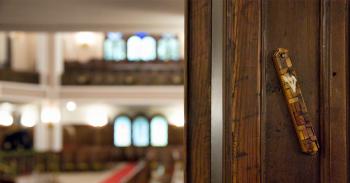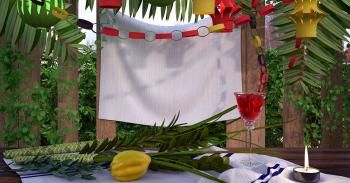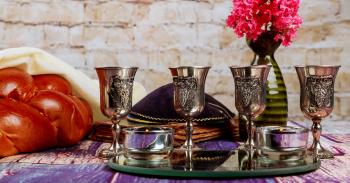
Have you ever wondered where Judaica got its name from?
Have you ever asked yourself where this tradition of beautiful art started from?
Are you a fan of judaica? You probably are, if you're on our site :)
Today, we're here to answer some of these burning questions, and more!
So read on, and let's discover some judaica secrets, together!
Wikipedia tells us Judaica is Jewish ceremonial art. We actually like this definition, since it tells us many things about the purpose, uses and even origins of judaica.
When we use the term 'Judaica', we usually refer to a wide variety of items; from a tallit, which is indeed, strictly ceremonial, and all the way to jewish literature, paintings and other forms of arts, which are not a part of our ceremonies, but often do refer to those. As long as it's about Judaism or the jewish people, it can be called judaica;
Take a painting of a stormy sea, and it's just your plain, beautiful and enchanting nonetheless, but non judaica art.
Name it "The Parting of the Red Sea", and there you have it - Judaica.
A beautiful wall hanging that says "Live, Love, Laugh"- great, but not Judaica.
A unique wall hanging that reads a touching home blessing - Judaica indeed.
Well, the term 'Judaica' was coined somewhere in the 19th century, but art and the jewish people have been here for far longer than that. It's safe to assume that our creative and innovative people have been making art, describing the world they see around them in song, sculpture and paint, for as long as they've been around.
If we were lucky enough to witness our matriarch Sara's drawings, we would probably be proud to title those as Judaica.
Searching for the origins of Judaica is looking through the history of jewish art, which is a fascinating thing to do.
Throughout the events described in our tanach, the bible, we find stories of great ingenuity and creativity. Even though it's not mentioned right there in the scriptures, some of our patriarchs and matriarchs were pretty talented people.
Yosef, David and Bezalel are portrayed as highly creative individuals, perhaps they were the makers of the very first pieces of Judaica.
The historic creations we see around us today were made during the last few centuries. Anything earlier than a few hundred years could not have made it down to these days.
Those centenarians are somewhat based on earlier creations, and those rely on what came even earlier, since that's the nature of art.
So maybe just for a moment, we can close our eyes, think of a beloved Judaica painting, and imagine its very first creator - perhaps a thousand years ago - using the materials they had around to create, which were probably similar but not exactly the same as we use to create art today.
They probably had on a robe and a head covering of some sort. No buildings and cars around, just one story homes and donkeys, roaming on the road and looking for a cure for that deadly cold that hit their 36 year old elderly grandma.
So they created art, to reflect their world, their present. They matted it out on a piece of cloth, which was later seen by the next generation, who mimicked it in its own way, passing down from one generation to the next, finally allowing us to have a glimpse of their life, the jewish life they led in those days. Maybe it looked like this cute print shows?
Because we're awesome! We're an ancient people, thousands of years old. We've been through a lot, and we all have a cousin in another country and even a different continent.
And now seriously, let's take a moment to reflect on how a new genre of art comes to be.
We all know that art mimics life which mimics art.
So it's only logical that changes in art happen the same way they do in life - gradually.
Day after day, month after month, year after year -
It's the year 187AC, a new theme for poems becomes a trend among the poets of the time. They sit around in their weekly poets panel, talking about how it's been 187 years since that fella Yeshua was killed, and it probably won't have any effects on life at all, and then they write a poem. Each from their own view, but a few influential poems about the same topic, get it going, and so it begins.
In the same manner, a new painting subject is a hit among medieval artists. They all attended the same Passover talk by their enthusiastic rabbi, who really described the parting of the red sea well. He used his hands and some wonderful adjectives, so everyone sitting at the synagogue could see it from their eyes - they were all there, just for a moment. And so, the artists of the bunch, went home with this vivid image of a biblical event, and drew it.
And so it continues.
Many creations around the same subject - Hashem, the jewish people, faith, our biblical stories.
As human beings, we look for structure. It's easier for us to understand the world when it's grouped into categories. A good example of this is sight - yes, our ability to see with our eyes.
Did you ever get the feeling that you know the person walking on the other side of the street? You actually don't, but they have a very familiar face. You might have even told yourself that they have "that kind of face". When looking at people, we group their looks into categories. We have several recognition structures, gradually created in our brains throughout life, and every new face we see is filed into its suitable drawer.
So if we intuitively categorize everything in life, even basic things like the faces we see around us every day, it's obvious that we feel better doing the same thing with art -
In order to better understand, take in, live with art, we need to tell ourselves something about it. Answer the very basic question - "where does this belong?". Same way some look at a painting and say - "modern abstract!", or "cubism". Framing our body of art as "Judaica" helps us know it, feel closer to it, feel like it's ours, like it's part of us. One could easily connect with the statement - "I'm Jewish, Judaica describes my faith in art".
Judaica items tell our story as a people. Discovering Judaica, exploring it, is unveiling the history of the jewish people.
When looking at the history of the jewish people, it's easy to think there's not much to unveil. Why? Since our faith is very much based on its history.
We're told to keep much of it the way it was, and not make any unnecessary changes.
We're told to maintain the same basic mitzvahs, so that we have the same daily acts as our forefathers, and our grandchildren will still do the same. That's the way Judaism has been kept for thousands of years.
A few examples for those types of mitzvahs are lighting the shabbat candles and wearing a tallit.
Think about it, your great grandma lit shabbat candles, perhaps using lovely candle holders like the Addi Mini, and your great grandchild will wear a tallit. There's something very reassuring in knowing that we've been doing the same as our forefathers, and that our offsprings will carry the same traditions.
So is there anything to unveil about the history of our people? If we've all been at it for so long, don't we already know what it looked like back then?
Well, in fact, there's a lot to discover. Especially through the peephole judaica provides us. How so?
Judaica items take us on a tour of the past, looking at the similarities, but also, at all that has changed.
Mitzvahs like the mezuzah, mounting those important scriptures in your home or place of business are a part of what's changed. The original meaning of the scripture to lead us to mount mezuzahs, has been updated throughout the years. The interpretation of the scripture has had a few lives, and today, the mezuzah serves as a reminder for the love of Hashem. Having it on our doorpost, looking at it and reflecting on Hashem's protection, is a way to wrap ourselves in our faith, that wasn't done a thousand years ago, but only a few centuries ago.
Taking a deeper look into the "mezuzah market" is a real eye opener. This interesting judaica item has had many incarnations. From a plain white plastic rectangle, which housed a piece of scroll - the same as we all knew as children, mezuzahs have taken a turn for the better. Artists now make mezuzahs in all shapes and forms and it's absolutely wonderful to see. From that plain white rectangle, to porcelain beaches, glass huppas and even pewter violins. And yes, we're still describing mezuzahs! These beautiful examples are just a drop in the sea of creativity. Looking at all the directions in which mezuzah design has spread out to, is definitely an indicator of how far along judaica has come through the years - keeping the same ancient traditions, but in new, upbeat, contemporary form.
Another form of art and judaica that evolves continuously, is song.
While lyrics might stay the same, when it comes to religious songs, the music often changes. Thinking of prayer songs, it's easy to remember various tunes we've heard for each, throughout the years. Whether it's a different synagogue or a different eda - origin, to have a different tune, or simply the fact that a new hit tune has made it to the top and now everyone's singing it. One of the reasons orthodox parents send their kids to yeshiva is so they come back with some updated tunes for the shabbat songs. We're kidding of course, but that's how it goes - a family is accustomed to singing their shabbat songs in a certain music, only to adapt it to another, when the kids grow up and start to bring in newer tunes.
Songs like Eshet Chail - Woman of Valor, are definitely Judaica, as they describe a woman who dedicates her time and efforts to her family and Hashem. A beautiful poem written so many years ago, and is still sung today, in many homes, before the Kiddush on Friday evening.
Has it always been like this?
How many tunes do you know for Eshet Chail? Just off the top of our heads right now, we can think of three different tunes. But the baseline - the lyrics, those important words remain the same, for many many years.
So we ask - was the song originally written to describe a real life woman? If so, we have to admit this is a somewhat surprising act of appreciation, especially seeing how widespread the song is.
Unlike other Judaica love songs, like those from Song of Songs, it seems like Eshet Chail was indeed written to portray a real life woman, and not the Shchina - Hashem's spirit. It has become such a common and touching way of showing our appreciation, that many people hang dedicated wall art in their homes. A great example of Eshet Chail wall art is this lovely wisteria print, and you can find many other unique Eshet Chail items in this dedicated category.
As we can see from this review, there are many options to choose from, when decorating the house and place of business with Judaica items.
Many people choose to decorate with Judaica items, and it's easy to see why -
Just like any other type of art, Judaica affects its surroundings. It changes the atmosphere of a room and can really light up any space.
These are all advantages that can be found when decorating your space with any type of art, but when decorating with Judaica items there's a special upside -
It is a great way of surrounding ourselves with divinity.
Judaica items act as a reminder of our association with our ancient people, who won't let go of potatoes, not for a single holiday meal.
Let's review a few fun Judaica items that can light up your home or place of business -
When you put a beautiful kiddush set like this one, on a delicate shelf, it's functional all week long, not only during shabbat. The sight of a kiddush set reminds us of our holy day, shabbat. How we wait for it all week long. Catching a glimpse of a nice kiddush set on a week day, reminds us of the smell of the synagogue on shabbat, it brings the love of our family meals into our hearts. We truly believe that having nice Judaica items around can elevate one's spirit, especially if you're an art lover who enjoys having unique items around the house.
We previously mentioned the non judaica example of home decor, which is the very popular "live, love, laugh" sign. Well, our artists know how we love a good lifestyle design option, so there's also a judaica version of it, right here - a colorful hamsa, with the words "love, health, happiness, success". Honestly, that's all we need in this life.
"Shema Israel"! Is there a more powerful pasuk for the jewish people? We say it every day, we shout it from the top of our lungs on Yom Kippur. It's so powerful it's become a phrase used to exclemate. So why not put it in your home, where everyone can see it and remember that we have Hashem to speak to, whenever we need support? Check out this beautiful wall hanging, showing stainless steel floating letters of the Shema.
Other floating letter signs to set the right tone in your home, are these home blessings in English and Hebrew.
Looking for other home blessing options? Have a look at this lovely category, with many options to choose from, so you can pick the right size, style and shape for your home or place of business.
Know a good doctor? It's funny how our mothers wanted us to become doctors, and now so many clinics do indeed carry jewish last names. In case you're looking to thank your doctor for their attention, want to congratulate a friend for graduating and adding the "Dr." title next to their name, or want to decorate your own practice, we have a whole category of Doctor Office Blessings, right here. Physician wall art is very popular, since doctors do God's work, and we want to show them our appreciation. Also, if we can help the Dr. by bringing in a bit of divinity into their office, why not do it?
To wrap this list up, we'd like to conclude by saying that Judaica is a fascinating field to explore. Every time we look deeply into it, we find out more about the jewish people.
We hope you've enjoyed this article and know where to look next time you'd like to get a nice piece of Judaica!



